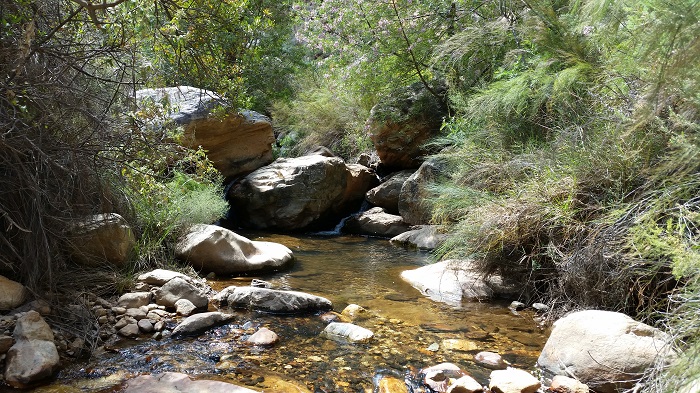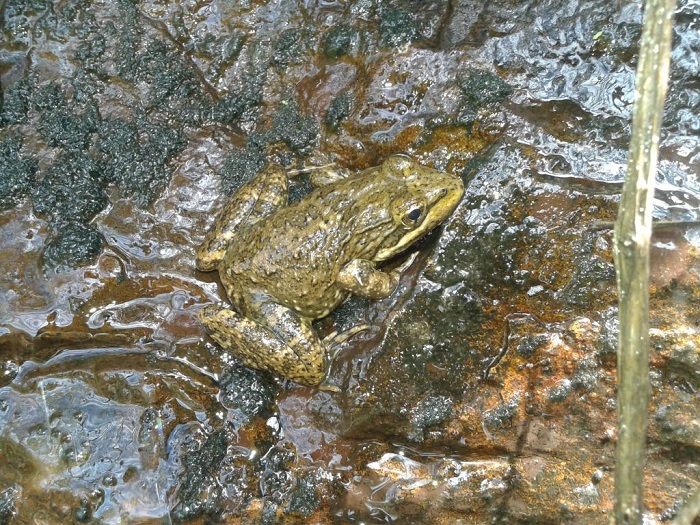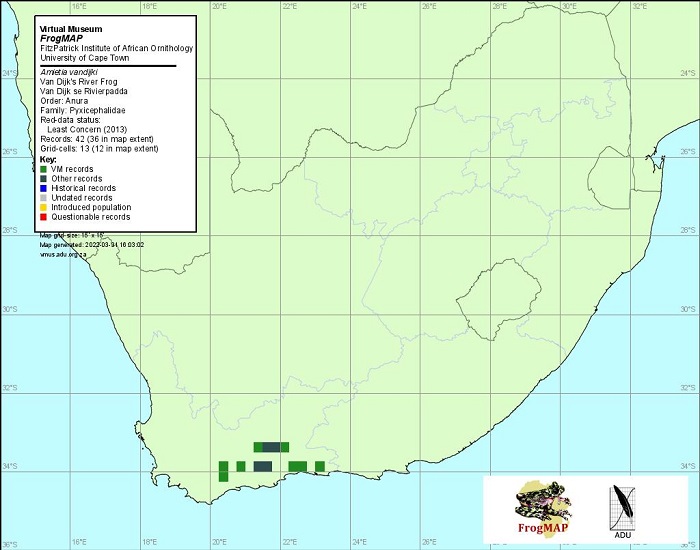View the above photo record (by Andre Marais) in FrogMAP here.
Find Van Dijk’s River Frog in the FBIS database (Freshwater Biodiversity Information System) here.
Family Pyxicephalidae
VAN DIJK’S RIVER FROG – Amieta vandijki
(Visser & Channing, 1997)
Identification
This species reaches a body length of 54 mm in males and 56 mm in females. A. vandijki is superficially similar to the sympatric A. fuscigula, and the two species are known to breed in the same pools. This should be borne in mind when identifying specimens from areas in which the species coexist. A. vandijki may be distinguished from A. fuscigula by the presence of a large pale mark in the middle of the back, and a prominent skin fold running from the back of the eye to the arm, obscuring the upper or entire tympanum. In A. vandijki, 2–3 phalanges of the fourth toe are free of webbing, whereas in A. fuscigula only half to one phalanx is free of webbing (Visser and Channing 1997).
The call is biphasic, consisting of a series of 10–15 clicks uttered within 0.8 s, followed by a harsh, pulsed croak about 0.25 s in duration (Channing 2001).
The tadpoles reach about 55 mm in length. They are dark brown or velvety black with deep, dark fins and a paddle-like tail. The tadpoles are easily distinguished from those of A. fuscigula, which have only a small amount of pigment in their tails (Channing 2001).
Habitat
This species inhabits Mountain Fynbos that receives annual rainfall of 300–800 mm, mainly in winter. The frog is associated with rocky streams on steep, well-vegetated slopes and forested gorges (Visser and Channing 1997). Breeding habitat includes pools on the sides of streams, and deeper, slow-flowing water.

Photo by Ryan Tippett
Behaviour
This species is active throughout the year. Breeding takes place October–December, after good rain. Little is known of the species’ breeding biology. Predators and food items have not been recorded.

Photo by Paul Bester
Status and Conservation
Status
A. vandijki is classified Data Deficient (Harrison et al. 2001; this publication). It is known to occur in Grootvadersbos Nature Reserve, Boosmansbos Wilderness Area, Swartberg Nature Reserve and Garcia State Forest (Harrison et al. 2001).
Threats
Present and predicted threats include damming of streams, wildfires and loss of habitat to invasive alien plants (Harrison et al. 2001).
Recommended conservation actions
Fieldwork is needed to collect additional distribution data and details of the life history of A. vandijki. The degree of genetic differentiation between the Swartberg and Langeberg subpopulations needs to be established. Habitat should be managed to ameliorate existing and predicted threats (Harrison et al. 2001).

Photo by Ryan Tippett
Distribution
A. vandijki occurs at medium to high altitudes in the Swartberg and Langeberg mountain ranges in the east of the Western Cape Province. Despite the addition of a number of new atlas records, the distribution of this recently described endemic species is not well known. The atlas data are accurate but incomplete.

Further Resources
Virtual Museum (FrogMAP > Search VM > By Scientific or Common Name)
More common names: Van Dijk se rivierpadda (Afrikaans)
Recommended citation format for this species text:
Channing A, Tippett RM. Van Dijk’s River Frog Amietia vandijki. BDI, Cape Town.
Available online at http://thebdi.org/2022/03/28/van-dijks-river-frog-amietia-vandijki/
Recommended citation format:
This species text has been updated and expanded from the text in the
2004 frog atlas. The reference to the text and the book are as follows:
Channing A 2004 Amietia vandijki Van Dijk’s River Frog. In Minter LR
et al 2004.
Minter LR, Burger M, Harrison JA, Braack HH, Bishop PJ, Kloepfer D (eds)
2004. Atlas and Red Data Book of the Frogs of South Africa, Lesotho and
Swaziland. Smithsonian Institution, Washington, and Avian Demography
Unit, Cape Town.

